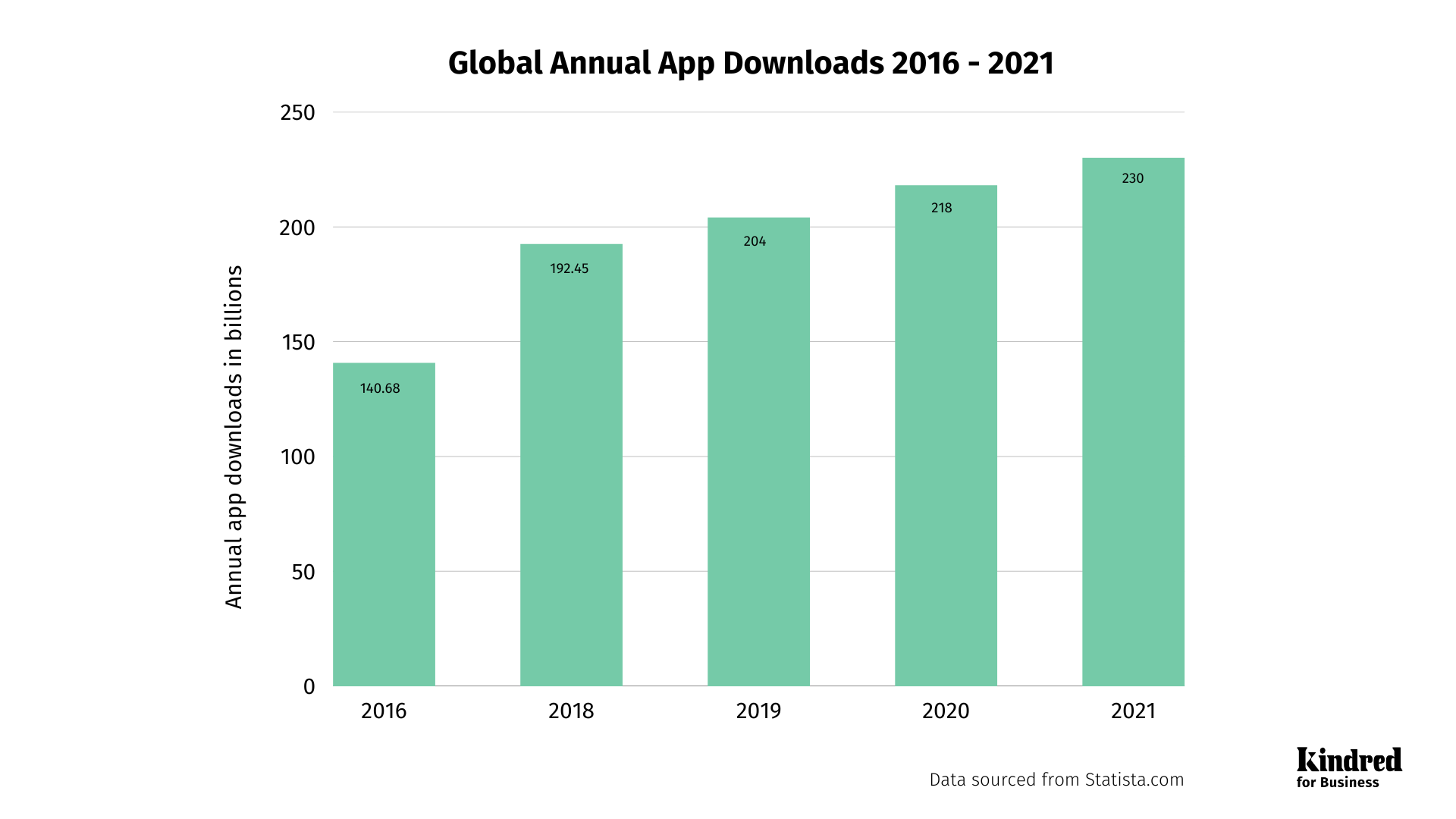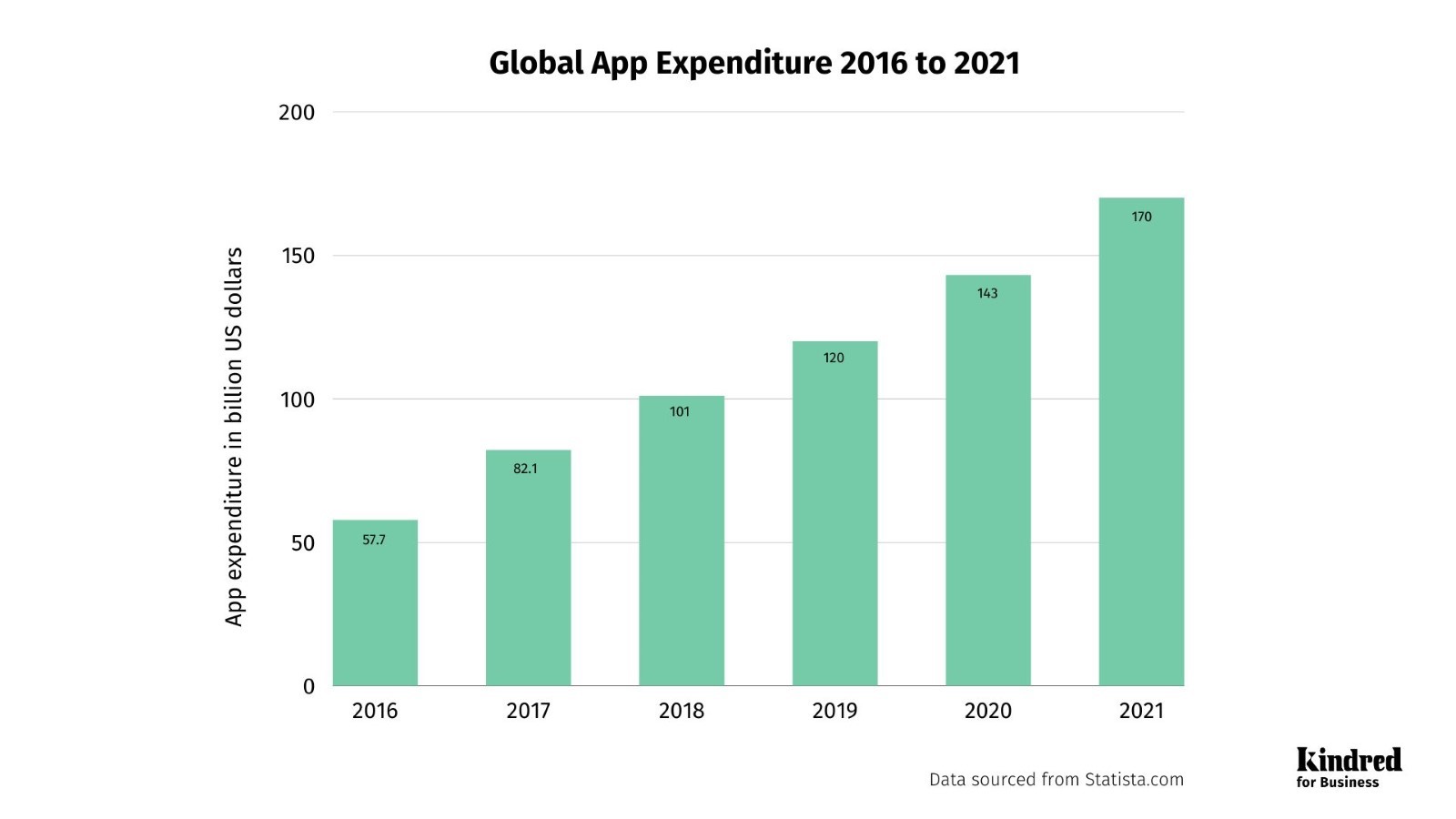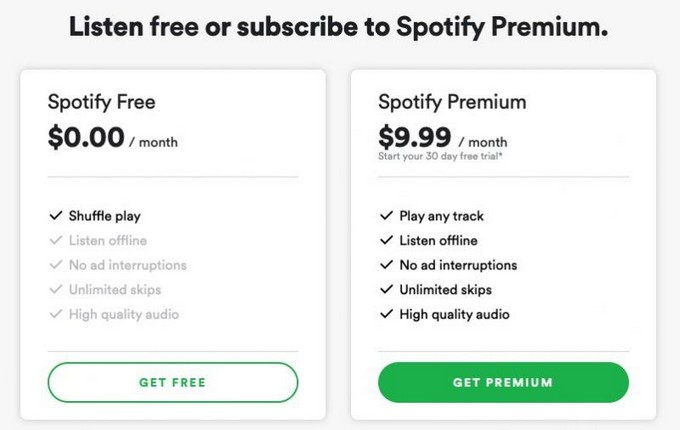You’ve finally done it!
After months of hard work, app glitches, scrapped Figma boards, and late-night developer calls, you’ve finally completed and published your app.
There’s just one thing missing, however. A monetization strategy.
Why an app monetization strategy is fundamental to your app’s growth
An app monetization strategy is essential to your app’s success. Whilst you may have already done the groundwork in the building stage, it also costs to maintain the app and publish regular updates.
According to Fierce Wireless, the cost of app maintenance can be roughly 15% to 20% of the total cost of building the app. For example, if it cost you $50,000 to build the app, annual maintenance costs could be around $7,500 to $10,000.
Moreover, without an app monetization strategy, your app cannot be profitable. It’s good to take advantage of the expanding market opportunity to not just make profit from one app, but potentially build an app-empire.
Last year saw 230 billion app downloads, a soaring increase from 140 billion app downloads in 2016. Predictably, there would’ve been an increase during the peak of the pandemic, but the data has shown that this trend is here to stay.

In addition, the amount of money spent in apps has also increased. In 2021, $170 billion was spent, showing a $50 billion increase since 2019.

Nail your target audience
Before finalising your app monetization strategy, it’s important to crack down on who exactly your audience is, as this will affect their response in how you choose to monetize.
Some questions you should consider:
- How old is my audience?
- How much disposable income do they have after essential expenses?
- What other app may the download as an alternative to mine?
- What is that app’s monetization strategy?
As the world is constantly changing, it’s good to revisit these sorts of questions as your audience’s needs and priorities change over time too.
How to monetize your app
-
In-app Ads
In-app ads could be a good app monetization strategy if you’re looking to generate revenue through sponsored ads. Users can download the app for free, and advertisers' market to your audience.
There are typically three ways in which in-app ads are monetized:
Cost Per Action (CPA): Sometimes misconstrued for cost per acquisition, but this refers to when a user completes a certain action after clicking on the ad. This could be something like a sign up or download - ultimately the sponsor will decide.
Cost Per Click (CPC): The rate charged every time your user clicks on the ad.
Cost Per Thousand Impressions (CPM): The rate charged for every 1,000 people who see an advertisement.
Which option you choose to pursue would depend on the sponsors’ preferences and your app engagement.
Ad relevancy is key here as poor ad quality can result in user churn, low conversion rates and reduced engagement. Digital Content Next reported that 78% of consumers are happy to receive ads if they are relevant to their interests, but irrelevant ads are considered a ‘failure’ by the app to deliver to them.
-
Premium account features
Another option is premium account features. Like with ads, the app is free to download but you charge extra for extra features and an enhanced user experience.
A good example of this is Spotify. You can listen to music for free on their app, but if you want a seamless audio experience with no ads, you need to pay monthly.

A common app monetization strategy within premium account features is tier pricing. Specifically, ‘Goldilocks Pricing’ which is when you offer three different tiers yet targeting most users to choose the middle option which feels ‘just about right’.
The different tiers:
Basic tier: This provides users with the essentials and is the most affordable.
Standard tier: This is an extra set of features on top of the basic tier. It usually has a desirable feature that the basic tier is missing, whilst still being more affordable than the premium tier which makes it the sweet spot.
Premium tier: This model is typically made for multi-app consumption. For example, if it’s a business, they may require multiple users to have access. Alternatively, Netflix’s premium tier allows for four screens to watch Netflix at the same time, versus their standard tier which only enables two.
To be successful in this strategy, you need to have a strong user base and a strong proposition.
-
Kindred for Business SDK
Another app monetization solution that has become increasingly popular over the past year, is our Kindred SDK. Our free zero-risk SDK enables you to generate revenue from your users even when they’re not using your app, widening the pool of maximizing monetization.
Once the SDK is installed, and users have opted into the feature, they can start saving money on online purchases through cashback savings from over 20,000 online shops. You will win by receiving commission on each online purchase through our extension, therefore not having to just rely on in-app monetization.
It’s provided as an additional revenue model. So, there’s no need to ditch ads or subscriptions. We seamlessly integrate into your app with no impact on UX and your other revenue streams.
How it works:
Ready to start generating additional revenue of up to $2 ARPMAU right away? Learn more here.
-
Charge for the app
To successfully charge for your app, it’s advantageous to have a strong audience. It may not be the most popular option nowadays, but apps with bullet-proof branding and a loyal user base can succeed.
It works with users paying a one-time fee for lifetime access to your app. Some apps, such as Airbush, offer a free trial then an annual payment made once for unlimited access to all features.
Selling an app which has never been trialled to a user is difficult. You really need to be creative and fair in the way that you sell it to garner commitment. In this case, you’ll really want to pour a lot of time and focus into App Store Optimization (ASO). This includes writing killer-copy, creating stand out graphics and clearly demonstrating how your app solves a problem for the user or improves their life satisfaction.
-
Subscriptions
The subscription model has increasingly become a popular way to generate consistent revenue for many businesses, especially apps. Revenue from global subscription is expected to reach $243 billion in 2022.
There are many apps that consumers pay for from fitness to dating apps and even just for pure entertainment such as Netflix. It’s become increasingly popular because of the value these apps provide compared to its alternatives.
For example, a fitness app with a personalised workout plan for $18 a month may be much more appealing than paying $40 per session with a personal trainer. Equally, $6.99 for a Hayu account to watch shows with no ads and on release date saves a lot of time for their user.
Apps which use subscriptions as part of their app monetization strategy usually offer a free trial for a couple of weeks, so their user has time to understand the product, how it works and hopefully commit. The app would also be free to download.
The good thing about having your users paying a subscription fee is that you can increase engagement. When people pay for something, they form a deeper level of commitment as they want to get their money’s worth.
On the other hand, you’ll constantly need to update the app with new features and exciting content so that your users remain active and spread the word.
-
In-app purchases
Last but not least, we have in-app purchasing as our final app monetization strategy. In-app purchasing has become a popular example of showing potential revenue generation through apps. Pokemon Go made a staggering $2 billion in their first two years from IAP.
For apps, it’s all about showing your customer that if they make a purchase within your app, there’s a reward on the other side. For example, an e-commerce brand may offer exclusive discount or free shopping through their app which, when maintained, can result in brand loyalty.
For mobile games, it could be paying for extra coins to complete a quest. As the user levels up in the game, they feel a sense of achievement. Something they may not have felt if they stuck to the free features.
What features or deal can your offer through IAP to enhance your user experience?
To truly maximize the potential of this model, constantly refresh and tweak your offerings to see what customers naturally gravitate towards. Use this data to continue to provide the best value for your users, as a result creating sticky brand loyalty.
Conclusion
To summarise, picking the right app monetization strategy starts with really knowing your audience and where your app fits into their lifestyle. Practice deep competitor research so you can see how other apps market their app and the monetization strategy that’s working (or not working) for them.
From this, you’ll be able to make decisions on which strategy to use and how your user would respond to it.
How many is too many?
Keep the model simple and prioritize UX. The examples mentioned in this article mainly only allow for one strategy to be active, besides our SDK.
Our SDK is an additional feature to any of the above strategies which enables you to expand the potential of revenue generation for your app. In an effortless, free and zero-risk way.
Want to learn how you can start earning additional revenue today? Visit this page.




